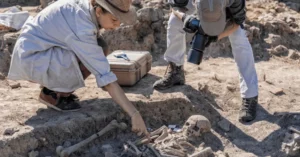AI Answer Evaluation Platform Live Now. Try Free Answer Evaluation Now
Industrial Archaeology
Industrial archaeology (IA) is a recent field of study focusing on documentation and preservation of humankind’s industrial heritage. It collects and studies artefactual evidence from factories, mills, mines and other places of human labor. Moreover, it also surveys and documents locations of labor and manufacture.

Though archaeology has deeply investigated ancient pottery kilns,farming fields and other workplaces from prehistory, industrial archaeology mainly addresses the time between industrialization and the culmination of the World Wars. It can also be called the field of discipline that uses ‘industrial monuments’ and machinery as socio-cultural markers of the past. Industrial monuments are relics of obsolete industrial and transportation systems.[1]
In the post-war era, the modern world witnessed several transformative developments like the decrease in use of steam powered locomotives and pumps, the decline of canals and the rapid rise of advanced transportation and infrastructure. As a result, the desire to preserve old machinery and industrial monuments became inevitable.[2]
British Industrial Archaeology
Britain birthed the idea of industrial archaeology in 1950. Marilyn Palmer best describes the two dimensional meaning of IA as –
- Interpreting physical evidence to reconstruct the working lives of our ancestors.
- A discipline aimed at assuring the survival of past industrial monuments.[3]
British scholars mainly focused on the techno-historical aspects of industries and their heritage. Michael Rix coined the term in 1955 and the Industrial Archaeology Research Committee was established in 1958. The scope and awareness of industrial heritage was further enhanced following the publication of Industrial Archaeology:An Introduction (1963) by Kenneth Hudson. The earliest IA work includes the preservation and restoration of the Iron Bridge, an 18th century cast iron structure in England. Which in 1986, became a UNESCO world heritage site.
Since landscape transformations bury and engulf unoccupied sites, industrial archaeology also needs fieldwork and excavation techniques in practice. Such works are evident in excavation reports like Bewl Valley Ironworks (1975) by David Crossley. Other prominent British industrial archaeologists include Sir Neil Cossons and Angus R. Buchanan.
American Industrial Archaeology
By 1968, two surveys of New England Textile Mills had been made in the United States. However, consummate IA developed in the country with the alliance of Historic American Engineering Record (HAER) and the Smithsonian Museum, particularly their curator – Robert Voge[4]. These entities eventually formed the Society for Industrial Archaeology (SIA) in 1971, with the aim to educate the public and government about industrial heritage.
Industrial archaeology flourished in the 1980s and 1990s with works of Bruce Council and Nicholas Honerkamp on an Iron works industry in Tennessee (1992). In 1994, Robert Gordon and Patrick Malone published Texture of Industry, An Archaeological View of the Industrialization of North America which comprehensively detailed over hundred sites, their landscapes and evolution of technological change[5]. American industrial archaeology focused more on socio-historical aspects and anthropology of workers as well as workplaces. This approach was advocated by George Teague in 1987.[4]
The international statutory body of industrial archaeology is founded under The International Committee for the Conservation of the Industrial Heritage (TICCIH) and represents over 40 nations.
Scope of Industrial Archaeology
- IA encompasses not just locations of manufacture and industry but also innovation, invention and development of industrial machinery.[6]
- In investigating past production, industrial archaeology could examine socio-economic factors and the nature of consumer-distributor relations in their contexts.
- As a discipline involved in heritage, it can systematically document significant industrial structures and also the social impact of industrialization on infrastructure and housing.[7]
- Industrial archaeology is inclusive of all professionals and academics including historians, anthropologists, museum curators, artists, architects etc. All of whom can have keen interest in industrial heritage in some shape or form.[7]
- The scope of IA in many cases limits itself to very specific types of research. For instance, P.E. Martin points out that though scholars in the past have used industrial archaeology to explore areas of socio-economic inequality and injustice, many of such works are not published in primary IA journals or conferences. Examples include – Paul Shackel’s work on Harper’s Ferry (1996,2004)[8]. This demonstrates the degree to which industrial archaeology has remained niche, in theory and in practice.
See Also
References
[1] Buchanan, R. Angus (1989). History and Heritage: The Development of Industrial Archaeology in Britain. The Public Historian, 11(1), 5–16. doi:10.2307/3378474
[2] Industrial Archaeology – Encyclopedia of Life Support Systems (EOLSS). (n.d.).
[3] Casella, E., & Symonds, J. (2005). Industrial Archaeology: Future Directions. (Global Contributions to Historical Archaeology). Springer Nature.
[4] Martin, P.E. (2009). Industrial Archaeology.
[5] Malone, P. M., & Gordon, R. B. (1994). The Texture of Industry: An Archaeological View of the Industrialization of North America. Oxford University Press.
[6] Cranstone, D. 2001 Industrial Archaeology—Manufacturing a New Society. In The Historical Archaeology of Britain, c. 1540–1900, edited by R. Newman, pp. 183–210. Sutton Publishing, Stroud, United Kingdom.
[7] Palmer, M. (1998). Industrial Archaeology: Principles and Practice (1st ed.). Routledge. https://doi.org/10.4324/9780203022993
[8] Shackel, Paul A. 1996. Culture Change and the New Technology: An Archaeology of the Early American Industrial Era. Plenum Publishing Corp, New York, NY.




